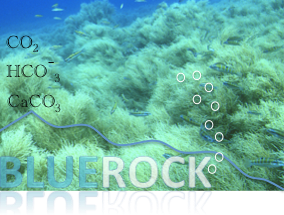
BLUEROCK: Efficiency of benthic communities to absorb carbon
- Post by: jocarher
- 11:19AM Apr 01, 2018
- No Comment
The ocean helps mitigate climate change due to its large storage capacity of CO2 enabled by the interplay of physical, chemical and biological processes. Oceanic CO2 absorption results in the sequestration in the ocean of 25% of the total emissions from human activity. However, given the high concentration of current atmospheric CO2 levels, close to 400 ppm, dramatic changes in sea water chemistry are currently occurring. These include a decrease in pH and carbonate ions (CO32-) as well an increase in bicarbonate ions (HCO31 -), known as ocean acidification (OA). The most direct consequence of this process is hindering the development of calcareous structures of marine organisms, but it also has the potential to trigger indirect impacts on ecosystems and the human populations that depend upon them, so it is generating great concern for the biogeochemical, biological and ecological health of the world’s oceans. Recent studies show that the negative effects of OA in organisms and ecosystems can become significant in the coming years, yet they remain poorly studied and quantified. This is due in part to the complexity of the carbon cycle, but also to the difficulties and large errors delivered when attempting to extrapolate the effects found in organisms under laboratory conditions to natural communities. Within this project we aim to gain a better understanding of the biogeochemical cycle of carbon at benthic communities off rocky bottoms, such as primary production, respiration, calcification and dissolution of CaCO3, and of the role of ecosystem engineer species (macroalgae and sea urchins); as well as the impacts of ocean acidification and rising temperatures over these processes. All these processes are key to understanding the complex carbon fluxes that regulate the absorption of CO2 in the oceans and help mitigate the increased amounts of atmospheric CO2. In this sense, we hypothetize that the spatial variations at geographical scales in the species composition and organization of benthic communities due to due to natural or anthropogenic causes, provide a perfect setting for studying these processes in detail. Following this approach, we specifically aim to combine the study of natural communities with manipulative experimentation in the laboratory as follows: (1) studying the biogeochemical cycle of carbon at contrasting benthic communities from rocky bottoms, such as macroalgae beds dominated by Cystoseira, Gelidium, Lobophora, and by encrusting corraline algae in order to determine which of them have the potential to act as sinks; (2) determining the sensitivity of these benthic communities to ocean acidification; and finally, with a more applied perspective, (3) assessing the efficiency of two ecosystem management tools, consisting either on marine reserves or strategies sea urchin densities reductions, to absorb CO2 and help mitigate ocean acidification. Finally, combining all these information we will be in a good position to determine which coastal benthic communities can act as carbon sinks and should be protected. Accordingly, accurate management strategies will be suggested in order to assure the development and persistence of these communities, which in turn will aid to the mitigation of ocean acidification.

